Spreadshirt is an online platform that allows users to create and sell custom apparel, accessories, and other products.
With a wide range of design tools and printing options, it's popular for businesses and brands looking to create unique merchandise. In fact, it has around 100,000 active sellers at the time of writing.
Here I’ll cover what you need to know about Spreadshirt, so you can decide if it’s right for you.
But, if you don't have the time to read this entire Spreadshirt review, here are the highlights:
Spreadshirt is an all-in-one ecommerce platform and print-on-demand (POD) service for those seeking a decent choice of print-on-demand (POD) products, printing methods, and sales channels.
That’s enough preamble; let’s dive into the nitty-gritty of this Spreadshirt review:
Quick Verdict
Overall, Spreadshirt is a solid choice for print-on-demand services, especially in the European market. With over 250 customizable products and multiple sales channels, it provides a versatile platform with no upfront costs.
The intuitive design tools and flexible selling options make it accessible for both new entrepreneurs and established businesses.
However, the platform's 20% marketplace revenue share is low, shipping times can be lengthy, and product quality reviews are mixed. Read on for a detailed analysis of Spreadshirt's features, pricing, and capabilities.
What is Spreadshirt?
Founded in 2002 in Leipzig, Germany, Spreadshirt's website states that it now has a $100m turnover and ‘is one the world's leading eCommerce and on-demand printing services.’
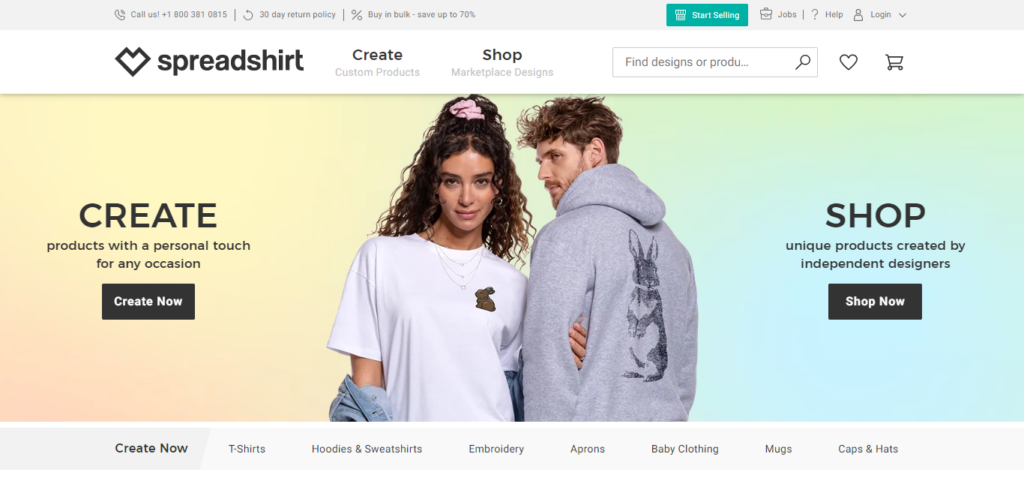
Where POD is concerned, Spreadshirt offers over 200 items, including t-shirts, sweaters, bags, and aprons, that you can easily customize with images and custom text.
For the uninitiated, “print-on-demand” (POD) is an eCommerce fulfillment model where products are printed after a customer places an order.
There’s no need for merchants to store inventory, pick, pack, or ship items, as the POD service will handle this all for you, thus empowering entrepreneurs to get into eCommerce without the risk of overstocking or wasting materials.
In the case of Spreadshirt, the process is as follows:
- Choose a product: Select the product you want to customize, such as a t-shirt or hoodie.
- Design your product: Use Spreadshirt’s design tool to create your custom design or upload your artwork or logo and place it on your chosen POD item.
- Set your price: Decide on your product’s selling price (remember to adjust your profit margin accordingly).
- Publish your product: Once you're happy with your design and pricing, publish your product to the Spreadshirt marketplace through SPOD or your own Spreadshop store (see below for more details).
- Receive orders: When a customer orders your product, Spreadshirt prints and ships the item directly to the customer.
- Get paid: You'll receive your earnings on each sale minus the cost of production and any applicable fees (more on this below).
Overall, the POD process with Spreadshirt is an easy and affordable way to create and sell custom products without the hassle of managing inventory or production. In addition, you don’t need any initial investment. You only pay when you get paid.
If a customer requests a refund, Spreadshirt requires the recipient's name, address, and payment details to process it. In addition, customers outside of Germany must also provide their Tax Identification Number.
If Spreadshirt doesn’t receive the correct tax ID, they’ll apply a 15% tax deduction to a portion of the sale. Spreadshirt’s Help Center refers to this as a Withholding Tax.
Looking for a SpreadShop review? This article is about Spreadshirt. If you meant to find information on SpreadShop, click here for our SpreadShop review. Otherwise, continue reading for our Spreadshirt review.
Spreadshirt’s Pros and Cons
Pros 👍
- You can create your own store for free
- There are 250+ POD products to choose from
- The design editor is easy to use
- The Spreadshirt marketplace is available to sell on if you would prefer to try and tap into an existing audience.
Cons 👎
- If you sell on the Spreadshirt marketplace, you only receive 20% of the sale price.
- You can only call the customer service team Monday to Friday, 8 am to 5 pm, or email; they’ll aim to respond within 24 hours.
- As of March 2023, the site has a 51.83% bounce rate.
Spreadshirt POD
Spreadshirt has over 200 POD products on its roster, including:
- T-shirts and tank tops
- Hoodies and long sleeve shirts
- Mugs
- Phone and tablet cases
- Caps and hats
- Children's and infant's clothing
- Aprons
Just select the product you want to customize. Then using Speadshirt’s design editor, you can upload images and add text. You can move the designs using drag-and-drop; for example, if you’re designing a t-shirt with a design on the front, you can drag the design lower or higher on the garment.
You can add your designs to the product's front, back, and sides and pick the product’s color.
You can also use Spreadsheet designs which you can filter according to whether they’re:
- Free
- Color adjustable
- Safe (i.e., won’t cause offense).
Once you’re happy with the end product, select the product size and quantity you wish to order before moving on to the printing method. In the case of our t-shirt, it was direct digital printing.

Printing methods vary depending on the product, but generally, there are five options to choose from:
- Flex printing: This involves cutting out a design on vinyl material and pressing it onto the fabric, resulting in a smooth, durable, and vibrant design that withstands multiple washes.
- Flock printing: This involves applying an adhesive layer onto the fabric and adding a layer of fuzzy fibers (called flock) to create a textured design with a soft, velvety feel and a high-quality look.
- Digital direct printing: A digital printer prints the design directly onto the fabric. It allows for high-resolution designs with many colors and gradients, but the print can fade over time with frequent washes.
- Special flex printing: This is a variation of flex printing that uses a metallic or holographic vinyl material to create a shiny or iridescent effect.
- Embroidery: This involves stitching the design onto the fabric and can result in a 3D and textured effect. It's a durable and high-quality option. Spreadshirt offers 20 different thread colors.
Sales Channels
When it comes to displaying your wares to customers, Spreadshirt offers three options:
Create a Shop (Spreadshop)
Spreadshop is a free eCommerce platform powered by Spreadshirt that you can use to build your own store.
You can link it to your socials, set retail prices, run discount campaigns, and customize your store to suit your brand. Of course, as this is your website, you’re responsible for driving traffic.
To get started, in the first instance, you have to register for an account with Spreadshirt with your email and password. Once you have an account with Spreadshirt, you can set up a Spreadshop from within your Spreadshirt dashboard.
Then, click on the + icon on the left-hand side of the dashboard, and you'll be directed to a popup where you input the name of your shop. Once you’ve done that, you’re walked through a series of steps to set up your shop.
There are no minimum sale requirements, and you also get access to an easy-to-use statistics app that enables you to track sales while you’re on the go.
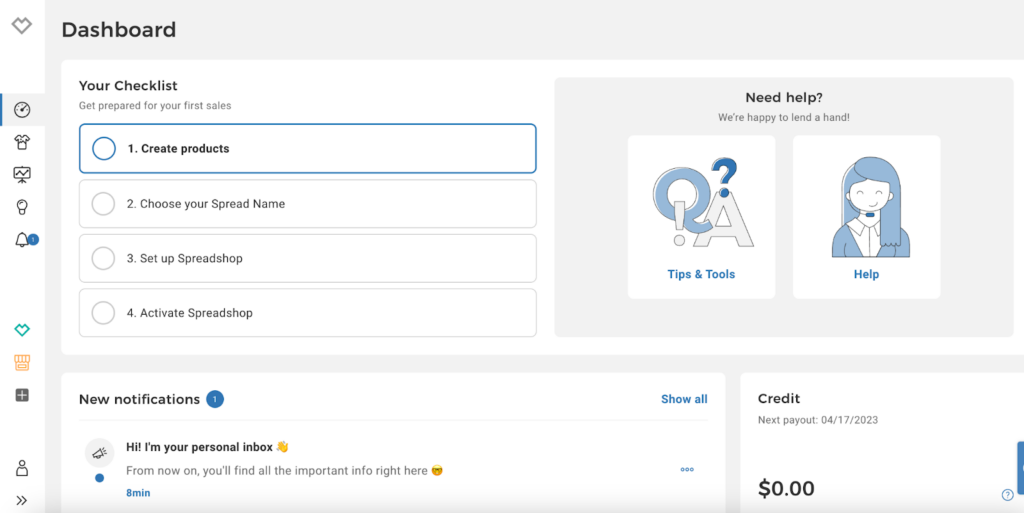
Sell on the Marketplace
The Spreadshirt marketplace, on the other hand, enables designers to sell their designs on the Spreadshirt website.
The great thing about using the marketplace is that it already has an established audience you can tap into. Plus, there aren’t any limits to the number of products designers can sell.
However, when you make a sale, you only receive 20% of the revenue generated; the rest goes to Spreadshirt.
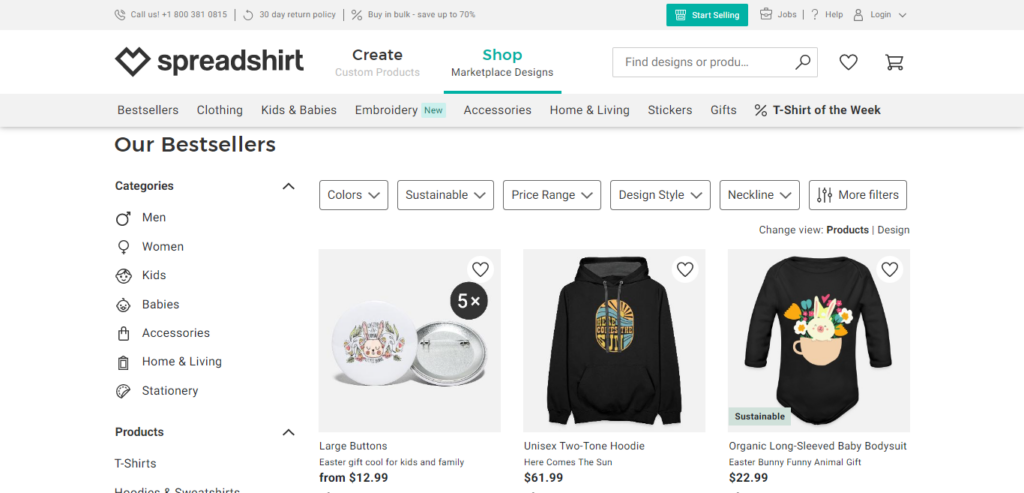
SPOD
Lastly, SPOD (Sell Print-On-Demand) is the best option if you already have an online store and want to integrate Spreadshirt POD products into your existing catalog.
SPOD integrates with popular eCommerce platforms, including:
- Shopify
- WooCommerce
- Magento
- Squarespace
- Order Desk
SPOD handles everything from printing and fulfillment to shipping and customer service.
Designers can customize their designs on over 250 products, including t-shirts, hoodies, socks, caps, hats, umbrellas, and home and living items.
Shipping and Fulfillment
When shipping Spreadshirt products, you can choose one of three delivery methods:
- Standard (seven to 14 days) without product tracking
- Premium (seven to 14 days) with product tracking and loss insurance
- Express (three to seven days) with guaranteed delivery.
Please note: shipping times vary based on the country you’re shipping to, and don’t apply to special finishing techniques that require more production time. For example, screen printing or embroidery.
Spreadshirt's shipping costs are calculated based on the delivery country, shipping option, and the value of shipped goods. Understandably, the price increases as the value of shipped goods increases.
For example, suppose you’re shipping within the USA. In that case, shipping costs are as follows for standard domestic shipping:
- $0.01 and above costs $3.99
- $9.99 and above costs $5.99
- $49.99 and above costs $7.99
- $99.99 and above costs $11.99
*The above prices refer to the value of the package.
Payments
Spreadshirt offers various payment options. However, these vary depending on your customer’s location. Typically customers from most countries (i.e., the UK, Canada, US, and AU) can pay for their orders using credit/debit cards or PayPal.
Credit/debit cards are automatically charged by Spreadshirt's financial service provider, ADYEN. However, the order is only processed once ADYEN verifies your customer’s payment details.
Pay by invoice is also possible for orders made on the German platform, spreadshirt.de.
Once a customer has paid, earnings are credited to your account and paid out monthly. The minimum balance before qualifying for a payout varies depending on the currency selected.
But, for example, in the US, EU, and UK, it’s 10 in their respective currencies.
It’s also worth noting that your previous month’s earnings are paid by the 15th working day of a payment month.
Pricing
As mentioned, there are no upfront costs for using Spreadshirt’s services. You just pay the base price and shipping for the product.
Spreadshirt's product prices are calculated based on three factors:
- The product’s base price
- Printing costs
- Design price (if applicable).
Printing costs are determined by the number of print areas used. Each product has at least one print area you can personalize with designs and text.
A standard printing fee is applied for each print area used. However, you can add multiple designs and text lines within each print area free of charge.
Where the design price is concerned, if you use a community design (i.e., not your own), a fixed design price is paid directly to the designer (if you use the same community design multiple times on one product, the design price is charged only once).
You can get a volume discount on up to 20 items. This discount varies based on the product. Spreadshirt will add this discount automatically, provided your order meets the criteria.
Is Spreadshirt Legit?
Yes, Spreadshirt is legit. It's not a scam. So, why are we addressing this? This is because if you look online, you’ll find some very mixed customer reviews of the company, from an unsatisfactory rating of 2.4 on Yelp to a solid 4.2 on TrustPilot.
So, what’s the truth?
On the negative side, it seems many customers complain that the quality of the products isn’t worth the money.
On the upside, many praise its flexibility and good customer service.
Whether these claims are valid is up to you to decide. Your best bet would be to order a sample product to assess the quality for yourself.
You could then take advantage of their returns policy, allowing you to get a refund within 30 days of receipt if you aren’t happy (their return policy only applies to non-personalized designs).
Spreadshirt Alternatives
If Spreadshirt isn’t for you, that’s fine! However, there are other POD services worth considering. For instance:
Printful
Printful is a print-on-demand platform that offers 329 POD products to choose from, including clothing, accessories, home decor, and more.
It integrates with major eCommerce platforms like Shopify, Etsy, Wix, and Squarespace. It also boasts an easy-to-use Design Maker you can use to create graphics and add text and images to place on POD products. Shipping times depend on product availability and delivery destination.
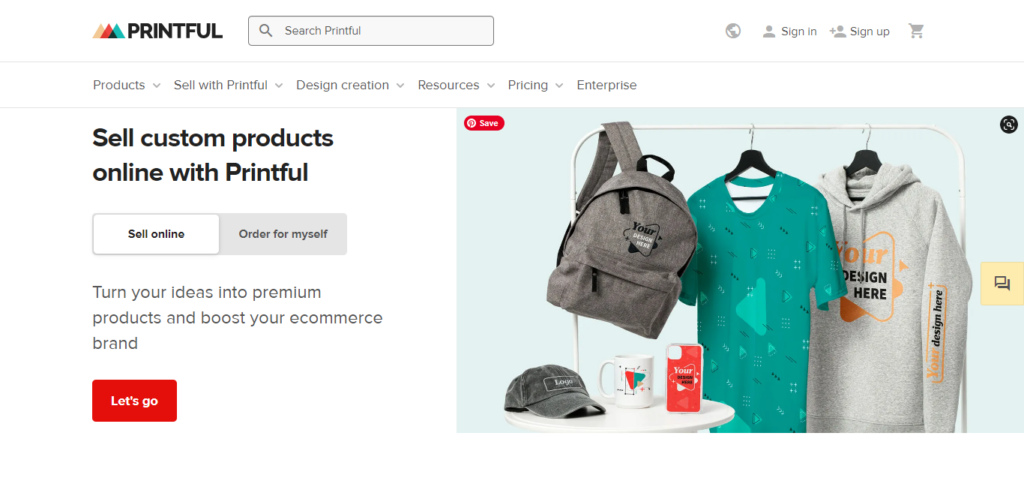
Printify
Like Printful, users can create and sell custom-designed Printify products on their existing online stores. They offer over 850 POD products, including clothing, accessories, and home decor. In addition, it integrates with popular eCommerce platforms like Wix, Shopify, and Etsy.
Key Printify features include its user-friendly Mockup Generator, access to a global network of printing partners with factories in the US, CA, Australia, China, EU, and the UK, and real-time shipping rates.
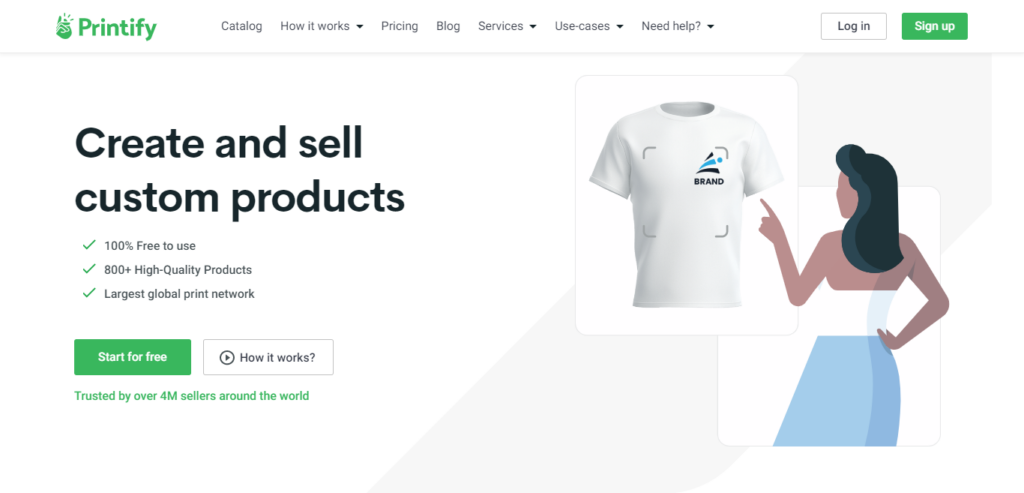
RedBubble
Redbubble is a print-on-demand marketplace where entrepreneurs can sell their artwork on various products, including clothing, phone cases, stickers, home decor, and more. Like Spreadshirt, Redbubble handles the printing, shipping, and customer service.
As well as being able to upload your own designs, Redbubble also includes a large selection of pre-created designs from independent artists.
In addition, it has a user-friendly design editor and, interestingly, allows your customers to customize your designs to suit their needs. If you don’t have a website, you can sell via Redbubble’s marketplace.
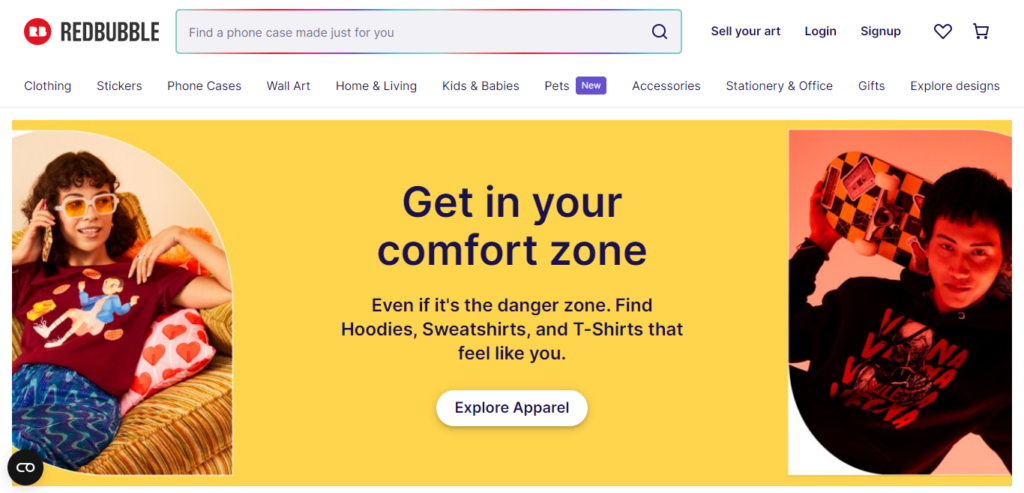
Spreadshirt Review: My Final Verdict
So, that brings us to the end of my Spreadshirt review.
Overall, I think the array of products, printing options, and sales channels is excellent. For this reason, Spreadshirt holds its own against its competitors. Plus, its design tool is easy to use.
Given that it’s a European business, it could be a good bet if you’re selling to EU customers. You also have nothing to lose by playing with the software for free before deciding.
Are you ready to start using Spreadshirt? Let us know how you get on in the comments box below.






Comments 0 Responses